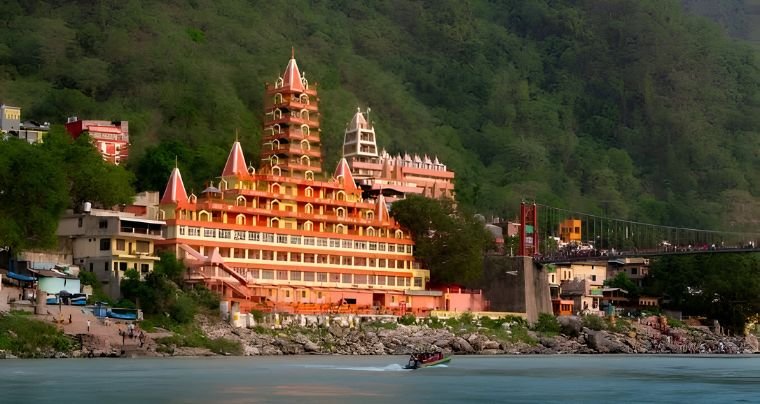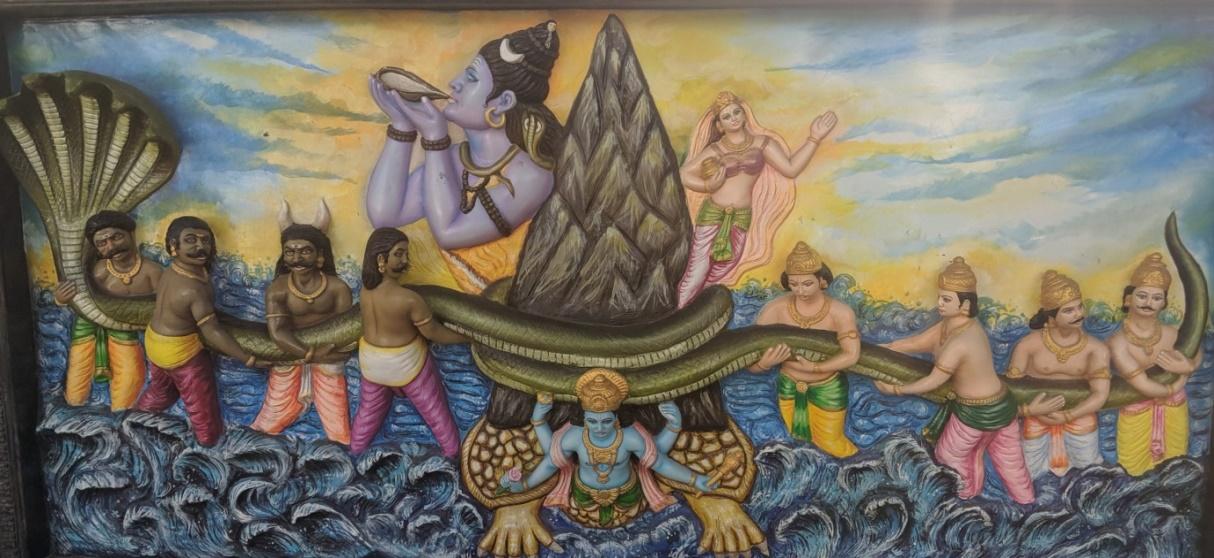Neelkanth Mahadev Temple Rishikesh
Introduction:
Neelkanth Mahadev Temple is one of the most famous Lord Shiva temples in India. The word Mahadev is made up of two words; Maha + dev. The word ‘Maha” refers to great and ‘dev’ means lord. So, the literal meaning of Mahadev is “the great god”. This is the title accorded to Lord Shiva. He is known as the destroyer within the ‘tridev’ that includes Brahma (the creator), Vishnu (the Preserver), and Shiva (the destroyer). Mahadev is the supreme lord and according to mythology, there are 108 names for Lord Shiva. He is the one who has the power to run the cycle of life from birth to death.
Thank you for reading this post, don't forget to subscribe!-
City: Neelkanth (Shiva)
-
Creator: King Bhoj’s nephew Udayaditya
-
Location: Pauri Garhwal, Rishikesh, Uttarakhand, India
-
Architecture style: Dravidian
Neelkanth Mahadev Temple Rishikesh:
This temple is a famous pilgrimage near Rishikesh. The temple lies above Swargashram adjacent to the Nar Narayan mountain range and is one of the most popular temples of Lord Shiva. This beautiful temple is surrounded by three valleys called Manikoot, Brahmakoot, and Vishnukoot which make it a sacred place at the convergence of two rivers Pankaj and Madhumati. The word Neelkanth is made up of two words, Neel + Kanth. The word Neel means “Blue” and Kanth refers to “throat”, meaning “the one with a blue throat”.
The idol is in the form of a Shivling, which is actually an abstract representation of Lord Shiva. It is made up of two words, shiv + linga. The word ‘shiv’ means Lord Shiva and ‘linga’ means sign or symbol, thus Shivling is referring to ‘Symbol of Shiva’.
The legend behind the Neelkanth Mahadev Temple Rishikesh
According to holy Hindu texts, during ancient times, there was a constant war between gods and demons. The demons defeated gods and took control of the entire universe. When all the devtaas approached Vishnu, he suggested to them to perform ‘sagar manthan’ and obtain ‘amrit’ – the divine nectar of immortality, which will make them invincible. Since the gods could not do it alone, the demons were also involved with a promise that all things will be shared equally.
So, the process started. Mount Mandara was used as a churning rod, and serpent king Vasuki was used as a churning rope. Out of the churning of the ocean, several items appeared, which included ‘halaahal’ (the deadly poison), which threatened to engulf the entire universe. All gods prayed to Lord Shiva to protect the universe. At their request, Lord Shiva consumed the entire poison. But, Lord Shiva’s consort, Maan Parvati placed her hand on his throat and prevented the poison to go down further and using her magical powers, stopped it there forever. Due to the poison, his throat became blue, and he got the name “Neelkanth’.
The architecture of the Neelkanth Mahadev Temple Rishikesh:
The architecture of the Neelkanth temple is very attractive and colourful. It has the Dravidian style especially at the Gopura and the shikhara. The images on the walls of the temple narrate the entire story of Samundra Manthan. Motifs and Friezes are perfectly carved on the temple walls and the main entrance is specially decorated with the sculptures of Gods and Demons.
The shivling is housed inside the garbh-gruha (the main sanctum of the temple). There is the Peepal tree on the temple premises. There is a belief that if you tie a thread around this temple, all your desires would come true one day. There a natural spring of hot water where devotees take a holy bath before entering the temple.
Mainly festivals celebrated at the Neelkanth Mahadev Temple Rishikesh:
Since the temple is devoted to Lord Shiva, so the two festivals celebrated here with great enthusiasm are Shivaratri and the Maha Shivaratri (meaning the great night of Lord Shiva). According to the Hindu lunisolar calendar, there are 12 Shivaratris in a year, one in each Hindu month.
But the greatest of them is the Maha Shivratri, which is celebrated on the night of trayodashi and chaturdashi of the Phalgun month according to the Hindu calendar. This festival has a lot of importance. It is believed that it was on this day; Lord Shiva performed the divine dance (Tandav) and saved the world from the pot of deadly poison (Kalkut Vish). It is also celebrated as the wedding anniversary of God Shiva and Goddess Parvati.
There is a strong belief that praying to Lord Shiva and offering water to Shivling on Maha Shivratri can help one overcome the bad situation.
This festival is celebrated in February or March. Devotees offer Bel leaves, milk, coconut, flowers, water, ghee, sandalwood, curd, honey, etc. to the Shivlinga and perform Shiv Abhishek. Many devotees observe a full day fast and break the fast the next day after taking a bath.
How to reach Neelkanth Mahadev Temple Rishikesh ?
Neelkanth Mahadev Temple is situated at the top of the hill which is surrounded by thick forest.
-
By Rail: The nearest station is the Rishikesh railway station which is about 32 km away from the Neelkanth temple. Outside the railway station, you can take a bus, taxi or any private transport to reach the temple.
-
By Air: The nearest airport is Jolly Grant Airport at Dehradun which is 49 km away from the temple. It is mainly connected with the most nearby cities such as Lucknow, Mumbai, Varanasi, Delhi, etc. You can take a bus or any public or private transport to reach the temple.
-
By Road: There is a good network of the road in the Pauri Garhwal and just 32 km away from the Rishikesh. One can take a bus or hire a taxi to reach the temple.
Best time to visit Neelkanth Mahadev Temple Rishikesh:
Temple is open for the devotees throughout the year, you can witness the two most sacred festival annually on the occasion of Shivratri (Jul – Aug) in the Shravaana month and the Maha Shivaratri (Feb – March) the holiest day for Shiv bhaktas (devotees of Shiva). But the best time is from mid-July to August when the weather is quite cool and pleasant.
Important points about Neelkanth Mahadev Temple Rishikesh:
-
Neelkanth Mahadev is present in the form of Shivlinga, which is an abstract form of Lord Shiva.
-
This temple is surrounded by dense forest and on the top of the hills, trekkers who love to trek can join the trekking way from Ram Ghat which is in Rishikesh to the Neelkanth temple. They have to cover a distance of 22km.
-
The temple is open round the year from 6 am to 9 pm. There are no entry charges to visit the temple.
-
The main offering to Lord Shiva is Bel leaves, milk, coconut, water, etc. during the special occasions and on a daily basis, devotees offer water to the shivling. Monday is the most auspicious day to offering water and payers to Lord Shiva.
-
The temple is decorated beautifully on the occasion of Shivratri, Maha Shivratri, and holy Hindu festivals. Thousands of devotees visit the temple annually.
-
Rishikesh is one of the most attractive and amazing places of tourism and for devotion. Many foreign tourists also come here regularly for the sake of spiritual happiness and blessings. The major tourist location of Rishikesh includes a lax hammock, Ram Jhula, Triveni Ghat, etc.
-
In addition to this, there are many places in Rishikesh to see. There are numbers of Ashrams and temple in the Rishikesh like Paradise Ashram, Geeta Bhawan and Rajaji Tiger Reserve, is popular for wildlife safari which nearest to the Rishikesh.
Neelkanth Mahadev Temple Rishikesh Mythological Background
Legend of Neelkanth: The Neelkanth Mahadev Temple is intricately linked to the profound mythological narratives of Hinduism, particularly those surrounding Lord Shiva. The temple is named after him as Neelkanth, which translates to “the blue-throated one.” This name stems from a significant event known as the Samudra Manthan, or the churning of the ocean, a crucial episode in Hindu cosmology. In this myth, the Devas (gods) and Asuras (demons) united to churn the cosmic ocean to obtain the nectar of immortality, or amrit. However, during this process, a potent and deadly poison emerged, threatening to obliterate all forms of life. In an act of supreme sacrifice and compassion, Lord Shiva consumed the poison to protect the universe. He held it in his throat, which turned blue as a result. This selfless act of bravery and protection is central to the temple’s significance, as it symbolizes Lord Shiva’s role as the protector of the cosmos.
Significant Pilgrimage Site: The Neelkanth Mahadev Temple is recognized as one of the most important pilgrimage sites in northern India. It draws thousands of devotees, especially during auspicious occasions like Maha Shivratri, when the temple is adorned with flowers, lights, and offerings. Devotees engage in various rituals, including chanting mantras, performing abhishekam (ritual bathing of the shivalinga), and offering bilva leaves, which are considered sacred to Lord Shiva. The temple’s serene location, surrounded by dense forests and the sacred waters of the Neelkanth River, enhances its spiritual ambiance, making it a perfect retreat for those seeking divine connection and tranquility.
Frequently Asked Questions About Neelkanth Mahadev Temple Rishikesh:
Q1. Where is the Neelkanth Mahadev Temple Rishikesh situated?
Ans: The Neelkanth Mahadev Temple is situated on the top of the hill and surrounded by a dense forest at the height of 1,330 meters. The temple is at a distance of 32 km from Rishikesh in the Pauri Garhwal district of Uttarakhand.
Q2: Why is Neelkanth Mahadev Temple Rishikesh famous?
Ans: Neelkanth temple is the place where Lord Shiva consumed a pot of poison to save the world from its harmful effects during the sagar manthan.
Q3: Is the Shivling at Neelkanth Mahadev self-originated?
Ans: As mentioned in Hindu holy texts, once Lord Shiva was meditating at Manikut. Goddess Parvati, the wife of God Shiva, came looking for him and she requested her to go back to Kailash Parvat. Before leaving, Lord Shiva installed a symbolic “shivling” where he meditated.
Q4: What is the meaning of Neelkanth?
Ans: Neelkanth means ‘one with a blue throat’.
Q5: Who is called Neelkanth?
Ans: Lord Shiva.
Q6: What is Neelkanth Mahadev Temple?
Ans: Neelkanth Mahadev Temple is a revered Hindu shrine dedicated to Lord Shiva, located about 32 km from Rishikesh, Uttarakhand. It is situated at the confluence of the Neelkanth River and is surrounded by lush forests.
Q7: Why is Neelkanth Mahadev Temple significant?
Ans: The temple is significant as it is believed to be the site where Lord Shiva consumed the poison (halahal) during the churning of the ocean (Samudra Manthan) to save the universe, earning him the name Neelkanth.
Q8: How to reach Neelkanth Mahadev Temple?
Ans: The temple can be reached by road from Rishikesh. Visitors can hire taxis or take local buses. The last part of the journey involves a short trek.
Q9: What are the opening hours of the temple?
Ans: The temple is generally open from early morning until late evening, but it’s advisable to check the exact timings before visiting.
Q10: Is there an entry fee to visit the temple?
Ans: No, there is no entry fee to visit the Neelkanth Mahadev Temple.
Q11: What is the best time to visit Neelkanth Mahadev Temple Rishikesh?
Ans: The best time to visit is during the months of March to June and September to November when the weather is pleasant.
Q12: Are there any accommodations near the Neelkanth Mahadev Temple Rishikesh?
Ans: Yes, there are several guesthouses, ashrams, and hotels in Rishikesh and nearby areas for visitors looking for accommodation.
Q13: Is photography allowed inside the Neelkanth Mahadev Temple Rishikesh temple?
Ans: Photography is generally not allowed inside the temple premises, but visitors can take pictures of the surroundings.
Q14: What should I wear when visiting the Neelkanth Mahadev Temple Rishikesh?
Ans: Visitors are advised to wear modest clothing as the temple is a sacred site. Traditional attire is appreciated.
Q15: Are there any rituals or festivals celebrated at the Neelkanth Mahadev Temple Rishikesh ?
Ans: Yes, major festivals like Mahashivratri attract large crowds, and special rituals are performed during these times.
Conclusion
In summary, the Neelkanth Mahadev Temple is not merely a place of worship; it embodies a rich history intertwined with mythology, culture, and spirituality. Its enduring legacy continues to inspire devotion and reverence among countless individuals, making it a cherished landmark in the heart of Rishikesh. The temple stands as a symbol of faith, sacrifice, and the eternal quest for spiritual enlightenment, drawing people from all walks of life to experience its divine presence. Whether one seeks solace, adventure, or a deeper understanding of Hindu traditions, the Neelkanth Mahadev Temple remains a beacon of light and spirituality in a rapidly changing world.







